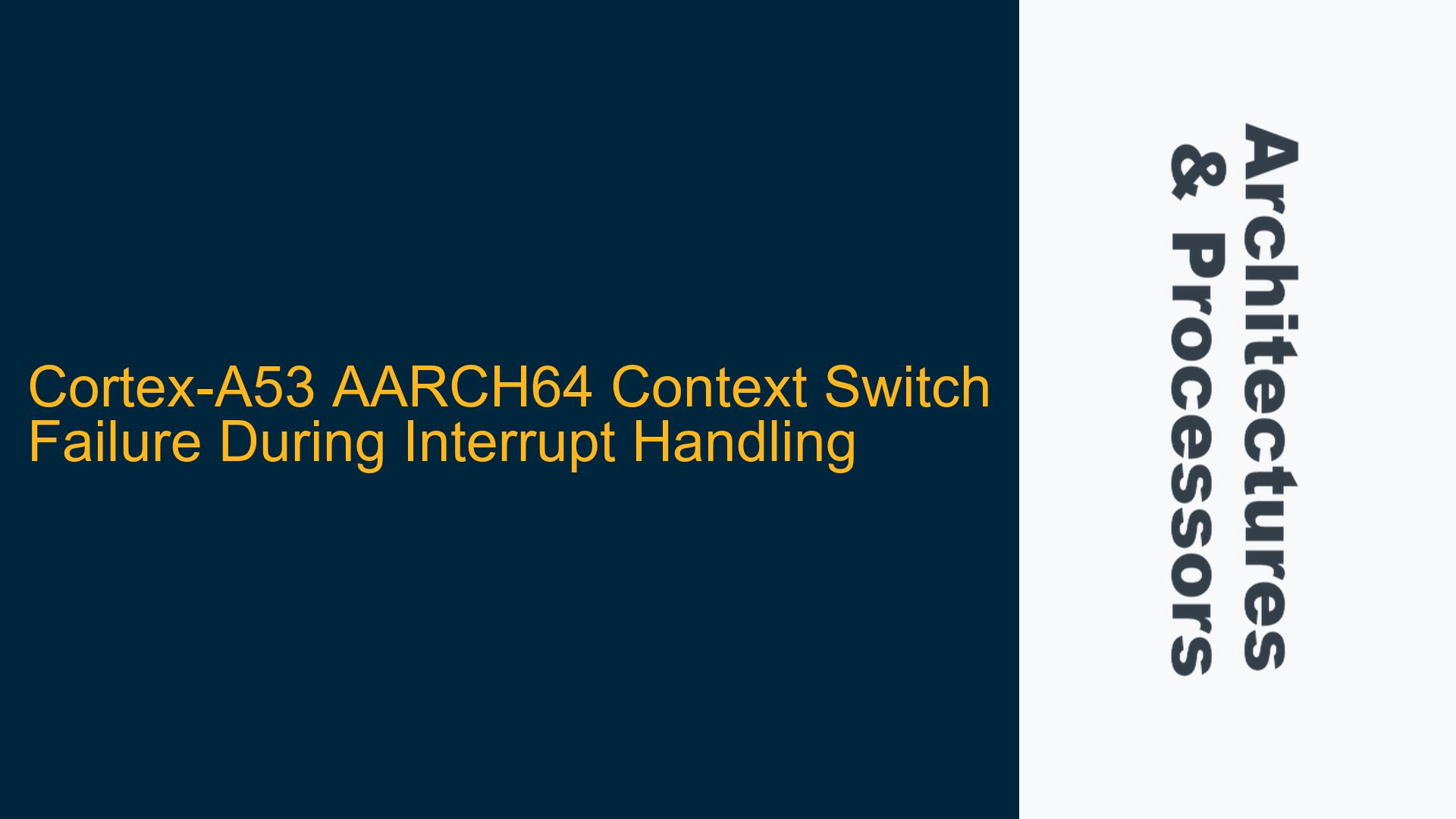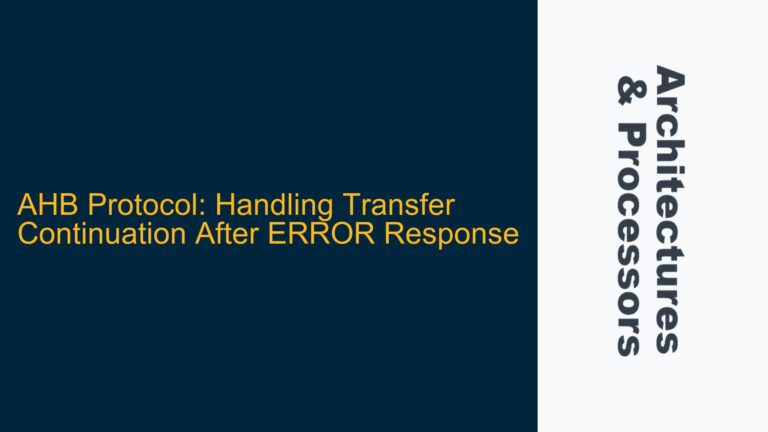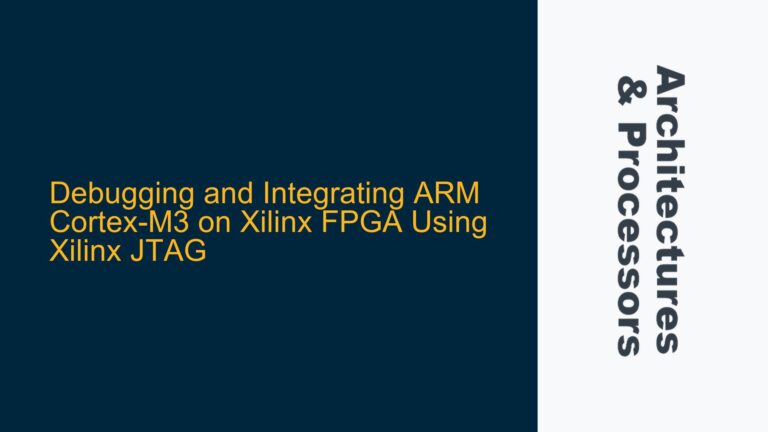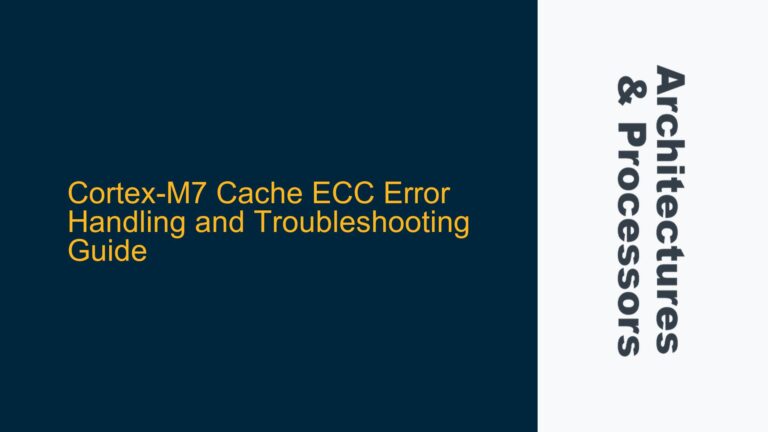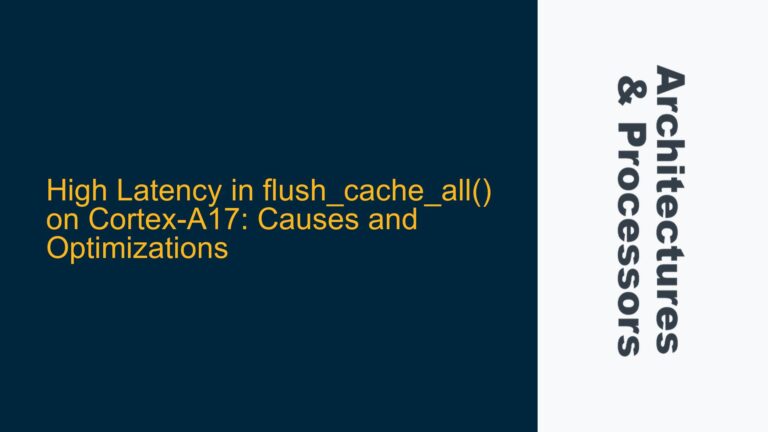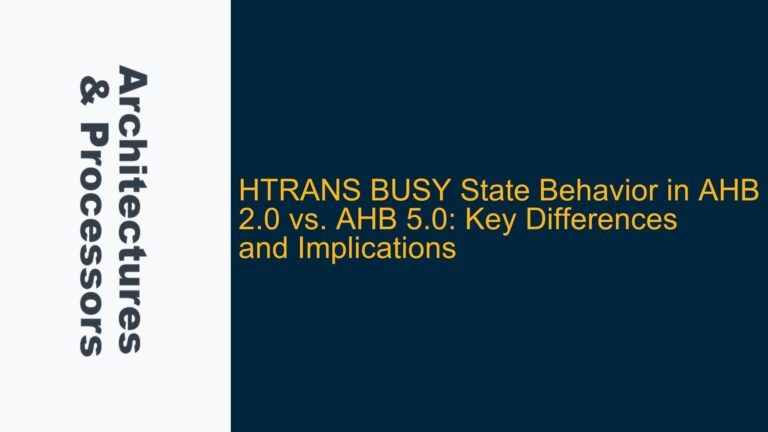Cortex-A53 AARCH64 Context Switch Failure During Interrupt Handling
The Cortex-A53 processor, part of ARM’s Cortex-A series, is widely used in embedded systems due to its balance of performance and power efficiency. However, implementing a preemptive context switch on interrupt in AARCH64 mode can be challenging, especially when dealing with custom or bare-metal implementations. The issue at hand involves a context switch routine that fails to properly save and restore the processor state during an interrupt, leading to unexpected behavior or system crashes. This post will dissect the problem, explore potential causes, and provide detailed troubleshooting steps and solutions.
Incorrect Stack Pointer Management and Register Save/Restore Sequence
The core issue revolves around the improper handling of the stack pointer and the sequence of register save and restore operations during the context switch. The context switch routine is responsible for saving the current task’s state (registers, stack pointer, program counter, etc.) and restoring the state of the next task to be executed. In the provided code, the save and restore sequences are not correctly aligned with the ARMv8-A architecture’s requirements, leading to potential corruption of the task state.
The Cortex-A53 processor in AARCH64 mode uses a set of general-purpose registers (x0-x30), special-purpose registers (such as SPSR_EL1 and ELR_EL1), and the stack pointer (SP). During an interrupt, the processor automatically saves the Program Counter (PC) and Processor State (PSTATE) in the ELR_EL1 and SPSR_EL1 registers, respectively. However, the remaining registers must be manually saved and restored by the context switch routine.
The provided code attempts to save the general-purpose registers (x0-x29) and special-purpose registers (SPSR_EL1, ELR_EL1) to the stack. However, the sequence of operations and the management of the stack pointer are flawed. Specifically, the code does not account for the fact that the stack pointer must be adjusted before saving registers and restored after loading them. Additionally, the code does not properly handle the critical nesting count and thread ID, which are essential for maintaining the integrity of the task state.
Potential Causes of Context Switch Failure
Misalignment with ARMv8-A Architecture Requirements
The ARMv8-A architecture specifies strict requirements for context switching, particularly in AARCH64 mode. The architecture mandates that the stack pointer must be 16-byte aligned at all times. Failure to maintain this alignment can result in undefined behavior or exceptions. In the provided code, the stack pointer is adjusted by multiples of 16 bytes, but the sequence of operations does not ensure that the alignment is maintained throughout the context switch process.
Improper Handling of Special-Purpose Registers
The special-purpose registers (SPSR_EL1 and ELR_EL1) are critical for restoring the processor state after an interrupt. The provided code saves these registers to the stack but does not ensure that they are restored in the correct order or with the correct values. This can lead to incorrect program counter values or processor state being restored, causing the system to crash or behave unpredictably.
Incomplete or Incorrect Register Save/Restore Sequence
The context switch routine must save and restore all relevant registers to ensure that the task state is preserved. In the provided code, the sequence of register save and restore operations is incomplete or incorrect. For example, the code saves the general-purpose registers (x0-x29) but does not properly handle the stack pointer or the link register (x30). Additionally, the code does not account for the fact that some registers may be used by the interrupt handler itself, leading to potential corruption of the task state.
Lack of Critical Section Management
The context switch routine must ensure that critical sections of code are protected from interrupts to prevent race conditions. The provided code does not implement proper critical section management, leading to potential corruption of the task state if an interrupt occurs during the context switch process.
Detailed Troubleshooting Steps and Solutions
Implementing Correct Stack Pointer Management
The first step in resolving the context switch failure is to ensure that the stack pointer is correctly managed throughout the context switch process. The stack pointer must be 16-byte aligned at all times, and the sequence of operations must ensure that the alignment is maintained. The following code snippet demonstrates the correct sequence of operations for saving and restoring the stack pointer:
irq_handler_stub:
/* Save x24, x25, x26, x27 to stack (could be irq_stack, or svc_stack) */
stp x24, x25, [sp, #-16]!
stp x26, x27, [sp, #-16]!
/* Fetch topofstack from current task pointer */
ldr x25, =pxCurrentTCB
ldr x25, [x25]
ldr x24, [x25]
/* Update pxCurrentTCB stacktop to where we will end */
mov x26, #(18*16)
sub x26, x26, x24
str x26, [x25]
/* Save general registers x0-x29 to the context stack */
stp x0, x1, [x24, #-16]!
stp x2, x3, [x24, #-16]!
stp x4, x5, [x24, #-16]!
stp x6, x7, [x24, #-16]!
stp x8, x9, [x24, #-16]!
stp x10, x11, [x24, #-16]!
stp x12, x13, [x24, #-16]!
stp x14, x15, [x24, #-16]!
stp x16, x17, [x24, #-16]!
stp x18, x19, [x24, #-16]!
stp x20, x21, [x24, #-16]!
stp x22, x23, [x24, #-16]!
/* Now move x25 to x1 and recover x24,x25,x26, x27 */
mov x1, x24
ldp x26, x27, [sp], #16
ldp x24, x25, [sp], #16
/* Now store last registers */
stp x24, x25, [x1, #-16]!
stp x26, x27, [x1, #-16]!
stp x28, x29, [x1, #-16]!
stp x30, xzr, [x1, #-16]!
/* Now save the special registers */
ldr x1, =ulCriticalNesting
ldr x2, [x1]
mov x3, sp
stp x2, x3, [x0, #-16]!
mrs x3, SPSR_EL1
mrs x2, ELR_EL1
stp x2, x3, [x0, #-16]!
/* Call the interrupt handler */
ldr x0, =RPi_IrqFuncAddr // Address to IrqFuncAddr
ldr x0, [x0] // Load IrqFuncAddr value
blr x0 // Call Irqhandler that has been set
/* Fetch topofstack from current task pointer */
ldr x1, =pxCurrentTCB
ldr x1, [x1]
ldr x0, [x1]
/* Update pxCurrentTCB stacktop to where we will end */
mov x2, #(18*16)
add x2, x2, x0
str x2, [x1]
/* Restore the special registers */
ldp x2, x3, [x0], #16
msr SPSR_EL1, x3
msr ELR_EL1, x2
/* Restore thread id and critical nesting count */
ldp x2, x3, [x0], #16
mov sp, x3
str x2, [x1]
/* Restore general registers x2-x30 */
ldp x30, xzr, [x0], #16
ldp x28, x29, [x0], #16
ldp x26, x27, [x0], #16
ldp x24, x25, [x0], #16
ldp x22, x23, [x0], #16
ldp x20, x21, [x0], #16
ldp x18, x19, [x0], #16
ldp x16, x17, [x0], #16
ldp x14, x15, [x0], #16
ldp x12, x13, [x0], #16
ldp x10, x11, [x0], #16
ldp x8, x9, [x0], #16
ldp x6, x7, [x0], #16
ldp x4, x5, [x0], #16
ldp x2, x3, [x0], #16
ldp x0, x1, [x0]
eret
Ensuring Proper Handling of Special-Purpose Registers
The special-purpose registers (SPSR_EL1 and ELR_EL1) must be correctly saved and restored to ensure that the processor state is preserved. The following code snippet demonstrates the correct sequence of operations for saving and restoring these registers:
/* Save the special registers */
mrs x3, SPSR_EL1
mrs x2, ELR_EL1
stp x2, x3, [x0, #-16]!
/* Restore the special registers */
ldp x2, x3, [x0], #16
msr SPSR_EL1, x3
msr ELR_EL1, x2
Implementing a Complete and Correct Register Save/Restore Sequence
The context switch routine must save and restore all relevant registers to ensure that the task state is preserved. The following code snippet demonstrates the correct sequence of operations for saving and restoring the general-purpose registers:
/* Save general registers x0-x29 to the context stack */
stp x0, x1, [x24, #-16]!
stp x2, x3, [x24, #-16]!
stp x4, x5, [x24, #-16]!
stp x6, x7, [x24, #-16]!
stp x8, x9, [x24, #-16]!
stp x10, x11, [x24, #-16]!
stp x12, x13, [x24, #-16]!
stp x14, x15, [x24, #-16]!
stp x16, x17, [x24, #-16]!
stp x18, x19, [x24, #-16]!
stp x20, x21, [x24, #-16]!
stp x22, x23, [x24, #-16]!
/* Restore general registers x2-x30 */
ldp x30, xzr, [x0], #16
ldp x28, x29, [x0], #16
ldp x26, x27, [x0], #16
ldp x24, x25, [x0], #16
ldp x22, x23, [x0], #16
ldp x20, x21, [x0], #16
ldp x18, x19, [x0], #16
ldp x16, x17, [x0], #16
ldp x14, x15, [x0], #16
ldp x12, x13, [x0], #16
ldp x10, x11, [x0], #16
ldp x8, x9, [x0], #16
ldp x6, x7, [x0], #16
ldp x4, x5, [x0], #16
ldp x2, x3, [x0], #16
ldp x0, x1, [x0]
Implementing Critical Section Management
The context switch routine must ensure that critical sections of code are protected from interrupts to prevent race conditions. The following code snippet demonstrates the correct sequence of operations for implementing critical section management:
/* Enter critical section */
ldr x1, =ulCriticalNesting
ldr x2, [x1]
add x2, x2, #1
str x2, [x1]
/* Exit critical section */
ldr x1, =ulCriticalNesting
ldr x2, [x1]
sub x2, x2, #1
str x2, [x1]
Conclusion
The Cortex-A53 AARCH64 context switch failure during interrupt handling is a complex issue that requires careful attention to detail. By implementing correct stack pointer management, ensuring proper handling of special-purpose registers, implementing a complete and correct register save/restore sequence, and implementing critical section management, the context switch routine can be made robust and reliable. The provided code snippets demonstrate the correct sequence of operations for each of these steps, ensuring that the task state is preserved and the system operates as expected.
